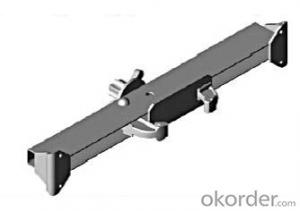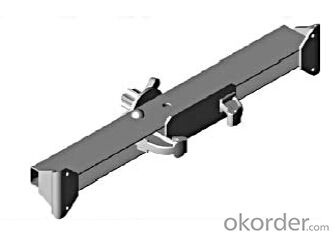Steel-Frame SF-140 for formwork and scaffolding systems
- Loading Port:
- Tianjin
- Payment Terms:
- TT OR LC
- Min Order Qty:
- 50 m²
- Supply Capability:
- 1000 m²/month
OKorder Service Pledge
OKorder Financial Service
You Might Also Like
Steel-frame Formwork SF-140
Characteristics:
◆ Few parts for fast forming.
◆ Max. Concrete pressure: 80KN/m2.
◆ Hot-dip galvanized steel frame.
◆ The thickness of plywood is 18mm & the panel is 14cm.
◆ Compatibility with Hunnebeck Manto system due to similar edge profile.
System Details & Application:
◆ Neat joint and fast assembling with aligning panel clamp.
◆ Flexible panel arrangement and height extension.
◆ The selection of panels.
◆ Kinds of panel connectors.
◆ Corner clamp application.
◆ Length adjustment application.
◆ Height adjustment & aligning strut.
◆ Walkway bracket & platform.
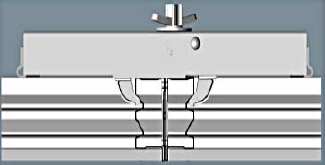
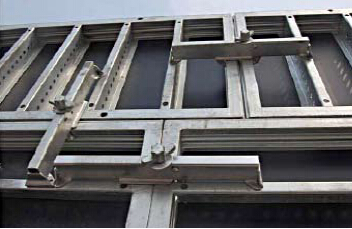
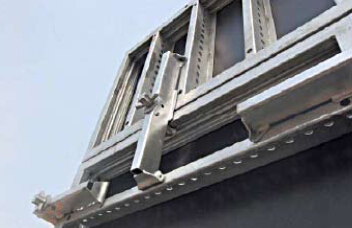
- Q: Can steel formwork be used for both horizontal and vertical concrete placements?
- Yes, steel formwork can be used for both horizontal and vertical concrete placements. Steel formwork provides a durable and rigid structure, making it suitable for various types of concrete placements. Its strength and stability allow it to withstand the pressure exerted by the wet concrete, ensuring that it maintains its shape and form during the curing process. Steel formwork is versatile and can be easily adjusted and assembled to meet the specific requirements of both horizontal and vertical concrete placements. Whether it is for constructing slabs, walls, columns, or beams, steel formwork provides a reliable and efficient solution for creating quality concrete structures.
- Q: What are the different types of reinforcement used in steel formwork systems?
- There are several types of reinforcement commonly used in steel formwork systems, including steel bars, mesh, and fibers. Steel bars, also known as rebars, are often used to provide structural strength and support within the formwork. Steel mesh, on the other hand, is typically used to distribute loads evenly and prevent cracking. Lastly, steel fibers can be added to the concrete mix to enhance its tensile strength and improve resistance to cracking and shrinkage.
- Q: How does steel formwork affect the overall strength of the structure?
- Steel formwork can greatly affect the overall strength of a structure in a positive way. Steel is known for its exceptional strength and durability, making it an ideal material for formwork. When used in construction, steel formwork provides a rigid framework that supports the weight of the concrete during the pouring and curing process. The use of steel formwork ensures that the concrete is properly contained and supported, preventing any deformation or collapse during the hardening phase. This is crucial for maintaining the structural integrity of the building, as any failure in the formwork can lead to serious consequences. Steel formwork also allows for greater flexibility in design, as it can be easily customized and shaped according to the desired structure. This versatility enables engineers and architects to create complex and innovative designs without compromising the strength of the building. Moreover, steel formwork has a longer lifespan compared to other types of formwork materials, such as wood or plastic. Its durability ensures that the formwork can be reused multiple times, reducing construction costs and minimizing waste. This not only makes it cost-effective but also contributes to sustainability in the construction industry. In summary, steel formwork positively impacts the overall strength of a structure by providing a robust and reliable support system for the concrete. Its strength, durability, and flexibility make it an excellent choice for ensuring the structural integrity and longevity of buildings.
- Q: How does steel formwork affect the overall sound insulation of a building?
- Steel formwork does not directly affect the overall sound insulation of a building. Sound insulation primarily depends on the quality and design of the walls, floors, and ceilings, which are independent of the formwork material. However, steel formwork may indirectly impact sound insulation during the construction phase. Steel formwork is known for its rigidity and strength, which helps in ensuring accurate and precise concrete pouring. This precise construction technique can minimize the gaps and imperfections that may occur during the casting of concrete. As a result, steel formwork can contribute to creating a smoother and more uniform concrete surface, reducing the chances of sound leakage through cracks or joints. Furthermore, steel formwork can be used to create smooth and even surfaces, which can facilitate the installation of soundproofing materials such as acoustic panels or insulation. These additional soundproofing measures, when incorporated during the construction phase, can enhance the overall sound insulation of the building. It's important to note that while steel formwork can indirectly influence sound insulation during construction, the primary factors affecting sound insulation are the materials and techniques used for constructing walls, floors, and ceilings. Architectural design, insulation materials, and sealing techniques play a crucial role in achieving optimal sound insulation levels.
- Q: Can steel formwork be used for projects with limited formwork stripping time?
- Projects with limited formwork stripping time can utilize steel formwork. Steel formwork is renowned for its durability and strength, rendering it suitable for diverse construction ventures. Unlike traditional formwork materials like wood or plywood, steel formwork can withstand higher pressures and loadings, enabling faster construction cycles. High-rise buildings, bridges, and infrastructure projects often employ steel formwork due to its time-sensitive nature. Its inflexible structure facilitates swift assembly and disassembly, minimizing formwork stripping time. Moreover, steel formwork can be reused multiple times, further diminishing construction time and expenses. Additionally, steel formwork guarantees precise dimensional control, ensuring accurate and consistent outcomes. This quality holds particular significance for projects with limited formwork stripping time since any errors or discrepancies in the formwork can result in delays and additional work. Nevertheless, it is essential to acknowledge that installing and removing steel formwork may require skilled labor and specialized equipment. Hence, meticulous planning and coordination are imperative to ensure efficient and safe utilization of steel formwork for projects with limited formwork stripping time.
- Q: How does steel formwork prevent concrete spalling?
- By offering a robust and inflexible framework, steel formwork effectively prevents concrete spalling. This framework securely holds the concrete in place while it undergoes the curing process. When the concrete is poured into the steel formwork, it assumes the shape of the structure and gradually hardens. The steel formwork guarantees the concrete's stability, preventing any sagging or slumping that could result in uneven curing and subsequent cracking. Concrete spalling arises when the surface of the concrete begins to flake or chip away, thereby exposing the underlying layers. This deterioration can occur due to various factors, including moisture infiltration, freeze-thaw cycles, and chemical reactions. Steel formwork serves as a protective barrier against these external influences, effectively thwarting spalling. The snug fit of the steel formwork impedes water from permeating the concrete, thus reducing the risk of moisture-related spalling. In addition, this formwork acts as insulation against temperature fluctuations, thereby minimizing the detrimental effects of freeze-thaw cycles. These cycles transpire when water infiltrates the concrete, freezes, and expands, leading to cracks and spalling. By maintaining a consistent temperature, the steel formwork effectively averts these detrimental cycles. Furthermore, steel formwork acts as a shield against chemical reactions that can contribute to spalling. Certain chemicals, such as sulfates or chlorides, have the potential to react with the concrete, causing its structure to deteriorate and spalling to occur. The steel formwork serves as a physical barrier, preventing direct contact between these chemicals and the concrete, thus minimizing the risk of spalling. In summary, steel formwork plays a pivotal role in averting concrete spalling by providing a robust structure that supports the curing process and protects against moisture, temperature changes, and chemical reactions. Its strength and durability ensure the integrity of the concrete, mitigating the risk of spalling and prolonging the lifespan of the structure.
- Q: How does steel formwork handle different concrete surface coloring techniques?
- Steel formwork is a versatile and durable material that can handle different concrete surface coloring techniques effectively. The primary advantage of using steel formwork is its smooth and non-porous surface, which ensures that the concrete's coloring techniques are evenly applied and achieve the desired result. When it comes to concrete surface coloring techniques such as staining, stamping, or integral coloring, steel formwork provides a stable and consistent base for these processes. The smooth surface of steel formwork allows for an even distribution of colorants or pigments, ensuring that the final concrete surface has a uniform and appealing appearance. Additionally, steel formwork's strength and rigidity make it suitable for various concrete surface coloring techniques. Whether it is stamping, which involves pressing textured patterns onto the concrete surface, or staining, which requires precise application of colorants, steel formwork provides the necessary support and stability for these techniques to be executed accurately. Furthermore, steel formwork's durability makes it resistant to damage during the coloring process. Concrete surface coloring techniques often involve the use of chemicals, dyes, or stains that can potentially cause damage to weaker or less resistant formwork materials. However, steel formwork's robustness allows it to withstand the harsh chemicals and coloring agents without compromising its structural integrity. In summary, steel formwork is an excellent choice for handling different concrete surface coloring techniques. Its smooth and non-porous surface ensures even distribution of colorants, while its strength and rigidity provide the necessary support for techniques such as stamping or staining. Additionally, steel formwork's durability makes it resistant to damage caused by chemicals or coloring agents, ensuring a successful and aesthetically pleasing outcome.
- Q: How does steel formwork contribute to the overall sustainability of the project?
- Steel formwork contributes to the overall sustainability of a project in several ways. Firstly, steel formwork is a durable and long-lasting material, which reduces the need for frequent replacement and minimizes waste generation. Additionally, it can be easily disassembled and reused in multiple construction projects, reducing the demand for new materials and minimizing the environmental impact. Steel formwork also provides excellent strength and stability, allowing for efficient and accurate construction, which in turn reduces construction time and energy consumption. Overall, the use of steel formwork promotes sustainable practices by reducing waste, conserving resources, and enhancing construction efficiency.
- Q: Are there any special considerations when using steel formwork in cold weather conditions?
- Yes, there are several special considerations when using steel formwork in cold weather conditions. Firstly, steel contracts and becomes more brittle in cold temperatures, which can increase the risk of cracks or fractures in the formwork. Therefore, it is important to ensure that the steel formwork is properly designed and reinforced to withstand the potential stress caused by temperature changes. Secondly, cold weather can also affect the curing process of concrete. Steel formwork tends to conduct heat away from the concrete, slowing down the curing process. This can result in insufficient strength development and compromised structural integrity. To mitigate this, additional measures may be required, such as using insulating materials or applying external heat sources to maintain optimal curing conditions. Furthermore, cold weather can also cause moisture to freeze on the surface of the steel formwork, leading to the formation of ice. Ice can increase the weight of the formwork and hinder the removal process. It can also cause damage to the formwork if not properly addressed. Therefore, it is essential to take preventive measures, such as using anti-freeze agents or providing adequate drainage to prevent ice buildup. Lastly, working in cold weather conditions can be challenging for construction workers. It is important to ensure that appropriate safety measures are in place, such as providing adequate insulation, heating facilities, and protective clothing to prevent workers from suffering from hypothermia or other cold-related illnesses. In conclusion, when using steel formwork in cold weather conditions, it is crucial to consider the increased risk of brittleness, the impact on concrete curing, the potential for ice formation, and the well-being of workers. By taking these special considerations into account, the use of steel formwork can still be efficient and effective in cold weather conditions.
- Q: What are the considerations when designing steel formwork for tunnels?
- When designing steel formwork for tunnels, there are several important considerations to take into account. Firstly, the formwork needs to be strong and durable enough to withstand the pressure and forces exerted by the surrounding soil and rock during tunnel construction. It should be able to resist bending, deformation, and potential structural failure. Secondly, the formwork should be designed to be easily assembled and disassembled, as tunnels typically require repetitive formwork installation and removal. It should allow for efficient and quick construction, reducing downtime and costs. Thirdly, the formwork should be designed with proper alignment and accuracy, ensuring that the tunnel's dimensions and shape are precisely maintained. This is crucial for achieving the desired structural integrity and functionality of the tunnel. Additionally, considerations such as corrosion resistance, waterproofing, and fire resistance should be taken into account to ensure the longevity and safety of the formwork. Overall, the design of steel formwork for tunnels needs to prioritize strength, durability, ease of installation, accuracy, and appropriate protective measures to ensure a successful and safe tunnel construction process.
Send your message to us
Steel-Frame SF-140 for formwork and scaffolding systems
- Loading Port:
- Tianjin
- Payment Terms:
- TT OR LC
- Min Order Qty:
- 50 m²
- Supply Capability:
- 1000 m²/month
OKorder Service Pledge
OKorder Financial Service
Similar products
Hot products
Hot Searches
Related keywords
